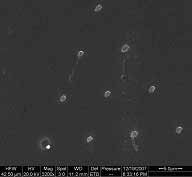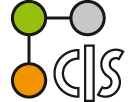Direct writing of metal structures with new inorganic precursors
Katharina Al-Shamery, Mathias Wickleder, Thomas Wich
Electron Beam induced Deposition (EBiD) has shown its advantages as a nanostructuring technique for the deposition of fine metal structures within the last decades [1]. However, metal deposits are still contaminated with carbon and oxygen [2], which leads to a dramatic change in physical and chemical properties of the deposits. In the course of a close collaboration between CIS members, a new carbon- and oxygen-free precursor has been developed [3] for e-beam direct writing. Based on this inorganic precursor, the process for direct writing in the scanning electron microscope (SEM) has been improved considerably: The substrate is spin-coated or stamped with the liquid precursor under shielding gas atmosphere and then transported into the vacuum chamber of the SEM.

Figure: Gold structures obtained via direct Electron Beam induced Deposition in a SEM using a (NO2)[Au(NO3)4]-precursor
After its evacuation, the precursor-coated substrate can then be observed using the SEMs electron beam. By increasing the electron dose density, the chemical dissociation process can be triggered, changing the morphology of the precursor layer visibly. After this so called “fixing step”, the substrate can be taken out of the SEM and developed simply by rinsing the non-fixed precursor away with water. The direct writing of metal structures has been demonstrated by the deposition of gold from a (NO2)[Au(NO3)4]-precursor in a tungsten-cathode SEM. Compared to common electron beam lithography, the number of process steps has been halved, enabling carbon- and oxygen-free gold-depositions [4]. Future challenges include the synthesis of similar metal-containing precursors, e.g. rare-earth-metals. Additionally, the process of substrate spin-coating will be improved in order to enable nanoscale structures.
[1] T. Wich. “Nanostructuring and nanobonding by EBiD”.
In S. Fatikow (editor), “Automated Nanohandling by Microrobots”, Springer Series in Advanced
Manufacturing. 2008.
[2] T. Wich, T. Luttermann, I. Mircea, and S. Fatikow.
“Characterization of EBiD-layers made from W(CO)6 and Co2(CO)8”.
IEEE-Transactions on Nanotechnology, submitted, 2007.
[3] M. S. Wickleder, O. Büchner F. Gerlach, M. Necke, K. Al-Shamery, T. Wich, and T. Luttermann.
“Synthesis, characterization and electron beam assisted decomposition of (NO2)[Au(NO3)4]”. Chemistry of Materials, submitted, 2007.
patents
[4] T. Wich, T. Luttermann, Prof. Dr. M. Wickleder, Dr. O. Büchner, F. Gerlach, M. Necke, H. Schnars, and Prof. Dr. K. Al-Shamery.
“Elektronenstrahlgestütztes additives Strukturierungsverfahren zur direkten Abscheidung von Metallen”. Patent (pending), 17.04 2007.







